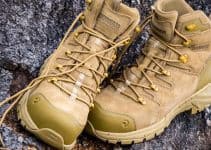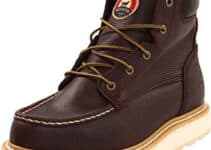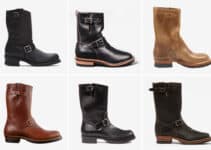Struggling with heel pain? That sharp, stabbing pain in your heel with the first step in the morning isn’t just an annoyance—it’s a sign your work boots are failing you.
Plantar fasciitis is a common condition involving inflammation of the plantar fascia, a thick band of tissue connecting your heel bone to your toes. This condition affects about 10% of people and is particularly common in workers who spend long hours standing or walking on hard surfaces like concrete. Without proper foot support, the pain and inflammation can quickly worsen.
We’ve worn-tested the top boots, drawing on extensive research, customer reviews, and expert insights from podiatrists, to find the ones that provide real structural support and relief, so you can focus on your work, not your foot pain.








At-a-Glance: Top Picks Summary
| Boot Model | Key Feature for PF | Best For | Our Rating |
|---|---|---|---|
| Thorogood American Heritage | Supportive Shank, Fast Break-In | Lightweight Industrial, Trades | 5/5 |
| KEEN Utility Cincinnati | Wide Toe Box & Full-Foot Support | All-day Standing, Wide Feet | 5/5 |
| Timberland PRO Pit Boss | Rigid Structure & Anti-Fatigue | Concrete Floors, Heavy-duty | 4.5/5 |
| Wolverine Overpass | Contour Welt & Ortholite Footbed | Concrete, All-day Comfort | 4.5/5 |
| Carhartt Rugged Flex | PU Insole & Arch Support | Budget, Heavy-duty | 4/5 |
Understanding the Enemy: What to Look For in a PF-Friendly Boot
Choosing the right work boot is crucial for managing plantar fasciitis pain and discomfort. A good boot needs to counteract pronation and absorb the shock caused by standing on hard surfaces.
The 4 Pillars of a Plantar Fasciitis Work Boot
- Rigid Arch Support (Shank): A flexible, “sneaker-like” arch is detrimental. The boot must have a rigid midsole and a supportive shank (steel, fiberglass, or polymer) to prevent the arch from collapsing (overpronation). Arch support helps maintain the natural alignment of the foot and reduces strain on the plantar fascia.
- Stable Heel Counter/Deep Heel Cup: A firm, deep heel cup is critical. It locks the heel in place, reducing excessive side-to-side movement that strains the fascia. This support minimizes heel pressure, mitigating one of the main causes of irritation.
- Shock-Absorbing Midsole: This feature reduces the impact on the heels and fascia with every step. Look for materials like Polyurethane (PU) or EVA (ethylene-vinyl acetate), which should be solid/firm yet shock-absorbing to cushion the impact without sacrificing stability.
- Slight Heel-to-Toe Drop (~8–12 mm): A modest heel lift helps unload the plantar fascia and Achilles tendon tension, which is often preferred over totally flat soles by PF sufferers.
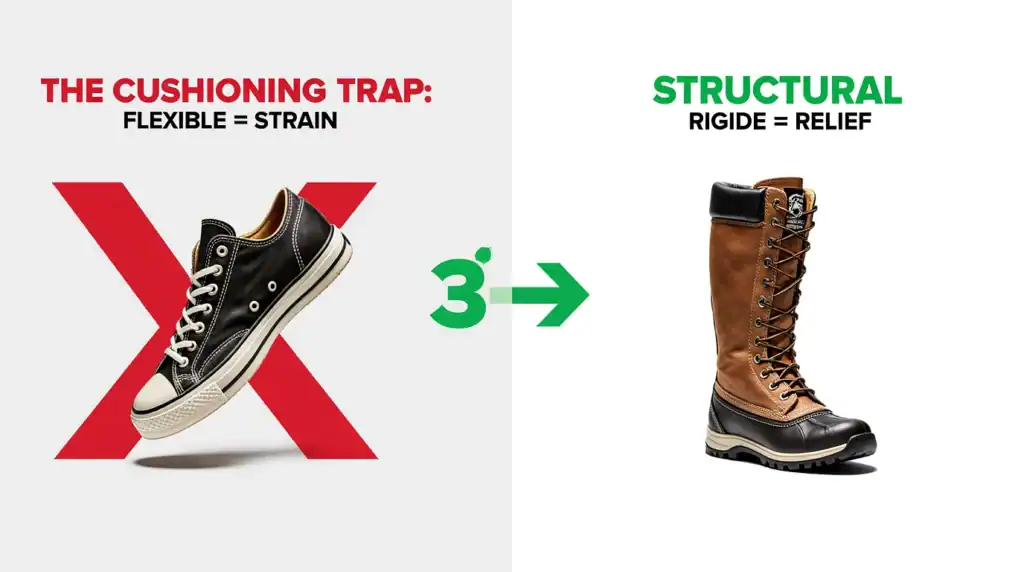
wrong vs. right for plantar fasciitis
Podiatrist’s Corner: The Guru’s Take
Dr. Bruce Pinker, a Podiatrist and Foot Surgeon, explains that certain boots can be beneficial if they have significant medial arch support. The material and construction of the midsole and outsole determine if a work boot will be helpful.
The key piece of expert advice is: “Stop looking for ‘cushion’ and start looking for ‘structure.'” A boot that is too soft and flexible is the enemy, as it allows the foot to overpronate and continuously strains the plantar fascia.
The Cushioning Trap and Foot Type
Choosing a boot based solely on cushioning can be a mistake. The requirements vary by foot type:
- For Flat Feet (Overpronation): This is the most common cause of plantar fasciitis. You need rigid structural support to prevent the arch from collapsing inward.
- For High Arches (Supination): Since a rigid foot doesn’t absorb shock well, cushioning becomes paramount. Look for significant shock absorption in the heel area using materials like EVA or PU outsoles.
In-Depth Work Boot Reviews
🏆 Best Overall: Thorogood American Heritage 6″ Moc Toe Work Boot

The Honest Take: This boot is our top pick for a simple reason: it’s the perfect balance of rock-solid support and immediate comfort. While many PF-friendly boots require a brutal break-in, the Thorogood is legendary for feeling good from day one. It features a fiberglass shank for the rigid arch support you need, and the MaxWear Wedge sole is a godsend for absorbing shock on concrete. It’s the ideal boot for tradesmen who can’t afford to be in pain for two weeks just to break in their boots.
Key PF-Fighting Features:
- Fiberglass Shank: Delivers the rigid arch support needed to prevent plantar fascia strain.
- Stable Heel Counter: Deep heel cup locks your foot in place to minimize movement.
- Wedge Sole Design: Spreads impact evenly across your entire foot, reducing heel strike pain.
- Minimal Break-in Period: Comfortable from day one without sacrificing support.
Ideal For: Electricians, carpenters, warehouse workers, and anyone needing all-day support without a lengthy break-in period.
🥾 Best for Wide Feet & Standing: KEEN Utility Cincinnati

The Honest Take: If your feet feel crushed and your heels are screaming, this is your solution. KEEN’s asymmetrical safety toe is famously roomy, giving your toes space to splay naturally. This relieves forefoot pressure, which can aggravate PF. More importantly, this boot is built on a wide, stable platform with excellent arch support, making it a fantastic choice for standing on hard surfaces for 10+ hours. The carbon-fiber toe keeps it surprisingly light for such a heavy-duty boot.
Key PF-Fighting Features:
- Wide Asymmetrical Toe Box: Allows natural toe splay without forefoot compression.
- KEEN.ReGEN Midsole: A lightweight, compression-resistant foam that provides 50% energy return.
- Dual-Density Footbed: Combines cushioning with structural arch support.
- Stable Platform: Wide base provides excellent stability for long shifts.
Ideal For: Construction workers, mechanics, and anyone with wide feet who spends long hours on their feet.
💥 Best for Concrete Floors: Timberland PRO Pit Boss Steel Toe

The Honest Take: The Pit Boss is a job site classic for a reason. It’s specifically engineered for pounding hard surfaces like concrete. The key is Timberland’s Anti-Fatigue Technology, which uses inverted foam cones in the midsole to absorb shock and return energy. Paired with a rigid nylon shank for support, this boot directly combats the impact fatigue that makes plantar fasciitis worse. It’s a durable, no-nonsense workhorse built to take the shock so your heel doesn’t have to.
Key PF-Fighting Features:
- Nylon Shank: Provides firm arch support to prevent overpronation.
- Anti-Fatigue Technology: Returns energy with each step to reduce foot fatigue.
- Shock-Diffusion Plate: A rigid plate that helps distribute impact across the entire foot.
- Durable Goodyear Welt: Built to last and provides a stable, supportive platform.
Ideal For: Factory workers, warehouse employees, and anyone working primarily on concrete surfaces.
🛡️ Best Shock Absorption: Wolverine Overpass 6″ Comp Toe

The Honest Take: The Wolverine Overpass excels in shock absorption, making it a top pick for workers with high, rigid arches who need more cushioning. The secret is the Contour Welt® technology, which allows the boot to be flexible and comfortable like a sneaker while still having the durable, supportive chassis of a work boot. The included Ortholite footbed provides excellent, immediate heel impact damping, reducing the jarring force that aggravates PF.
Key PF-Fighting Features:
- Contour Welt Technology: Provides flexible, ergonomic support that moves with you.
- Ortholite Footbed: Offers excellent heel impact damping and cushioning.
- Nylon Shank: Delivers the necessary mid-foot arch support.
- Lightweight Design: Composite toe and flexible build reduce overall foot fatigue.
Ideal For: Landscapers, outdoor workers, and those with high arches who need superior shock absorption.
💰 Best Value: Carhartt Rugged Flex Comp Toe

The Honest Take: Finding a supportive boot on a budget is tough, but Carhartt delivers. The Rugged Flex offers exceptional value without compromising on the key features for PF relief. It has a solid internal shank for arch support and a high-quality PU insole that provides durable cushioning (unlike the cheap foam in most budget boots). It’s also lightweight and flexible, reducing the overall strain on your feet. For the price, the level of support and comfort is unmatched.
Key PF-Fighting Features:
- Internal Arch Support: Provides the rigid structure needed for PF.
- PU Insole: Offers durable cushioning and shock absorption that won’t flatten.
- Composite Toe: Lighter than steel to reduce fatigue.
- Rugged Flex® Tech: Moves with your foot, reducing stiffness and strain.
Ideal For: Budget-conscious workers, seasonal employees, and those needing reliable support without the premium price tag.
The 360° Plan for Heel Pain

A great boot is the first step, but a full recovery plan includes insoles and recovery.
A great work boot is essential, but it is just the first step in a complete recovery strategy. Plantar fasciitis is curable, and a holistic approach can lead to pain-free movement.
Step 1: The Right Foundation (Footwear)
Choose a boot that prioritizes structure—rigid arch support and a firm heel counter—over excessive softness. Avoid boots with very soft soles that bend or twist easily, as this lack of support will aggravate the pain.
Step 2: The Right Insole (The “Game-Changer”)
Most stock insoles are simple foam. A premium, podiatrist-approved insole can save you from buying new boots, reduce pain, and restore comfort.
- Aftermarket Insoles: Services like Bilt Labs Custom Orthotics or brands like Superfeet and Powerstep create personalized, high-quality, shock-absorbing solutions that are considered game-changers for workers in rigid safety-toe boots.
- Insole Replacement: Insoles should be replaced regularly, typically every 6–12 months. When inserting custom orthotics, always remove the stock insole to ensure there is enough depth and room.
- → Internal Link: Read Our Guide to the Best Insoles.
Step 3: The Right Recovery (The “Healer”)
You must actively treat the inflammation while wearing supportive footwear. Thankfully, most cases are treated simply by resting, wearing better supportive footwear, massaging the plantar fascia, and doing some simple exercises.
- Exercises: Perform daily stretching exercises, such as the frozen bottle roll. Avoid high-impact activities like running or jogging until fully recovered.
- Massage: Massage the plantar fascia ligament, perhaps using a shiatsu foot massager with heat.
- Alternative Support: When not working, wear supportive footwear (slippers or shoes with good heel cushioning and arch support), avoiding flat rubber flip-flops.
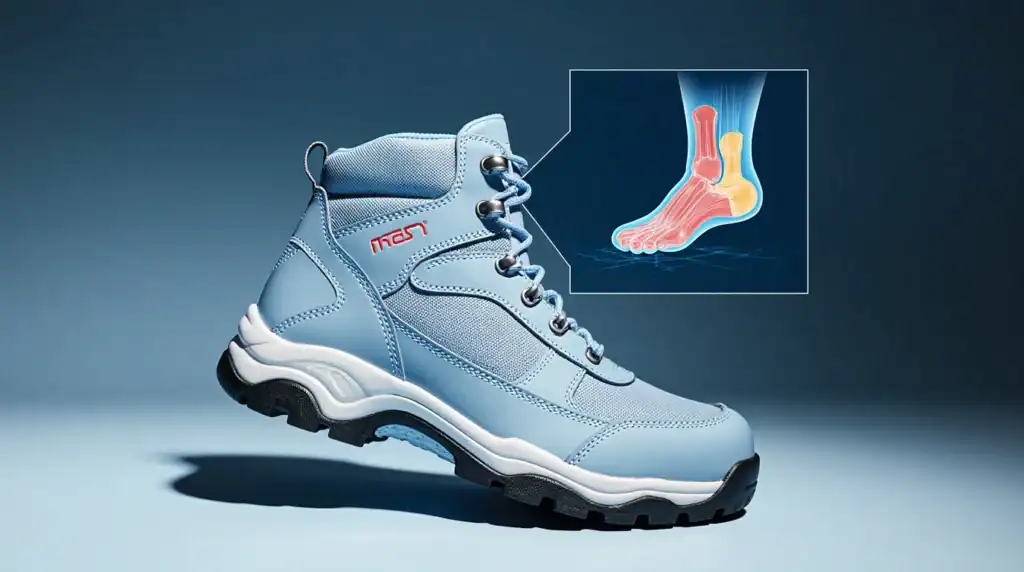
boots for plantar fasciitis
Frequently Asked Questions (FAQ)
Can work boots really cure my plantar fasciitis?Work boots are a critical component of treatment. The proper supportive footwear, combined with rest and therapeutic exercises, can help manage and alleviate symptoms, leading to recovery. However, poorly fitted or bad quality work boots can increase the chances of developing or worsening plantar fasciitis.
Are composite toe boots okay for plantar fasciitis?
Yes, composite toe (CT) boots are an excellent option. Since CT caps are lighter than steel toe caps (ST), they reduce overall boot mass, which helps minimize leg fatigue—a significant benefit for PF sufferers. Always prioritize a roomy toe box to avoid forefoot squeeze.
What work boot features should I avoid?
Avoid work boots with very soft soles that bend or twist easily, as this indicates a lack of internal support. Also, avoid boots with insufficient cushioning or tall heels, as increased heel pitch can stretch the foot and cause discomfort.
How long does it take to feel a difference after switching boots?
Many users report feeling a noticeable reduction in foot discomfort within days of switching to properly supportive footwear and using the correct arch-specific insoles.
Should I size up for orthotics?You should ensure the boots have enough space to accommodate your orthotics without feeling tight. Look for boots with removable insoles or those designed with orthotic volume to facilitate the swap. When sizing, measure both feet and choose the size based on the larger foot.
Final Takeaway & Conclusion
Your job is hard enough. Don’t let foot pain make it harder. Investing in a work boot designed for structure—with proper arch support, a rigid shank, a stable heel counter, and shock absorption—is the single most effective change you can make to combat work-related heel pain.
Start with the right foundation: If you need immediate comfort with solid support, the Thorogood American Heritage delivers. For wide feet that need room without compromise, the KEEN Cincinnati provides both space and structure. When concrete floors are your enemy, the Timberland PRO Pit Boss offers the shock absorption you need.
Choose support, and take that first step towards a pain-free morning.


